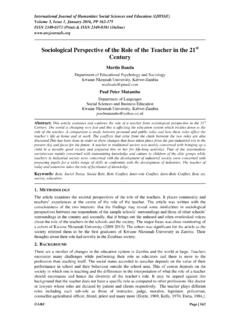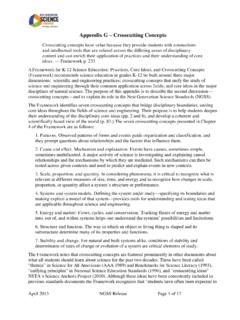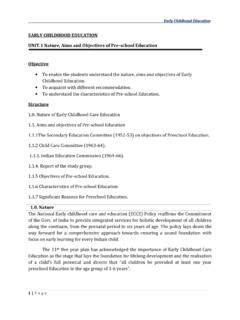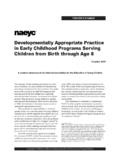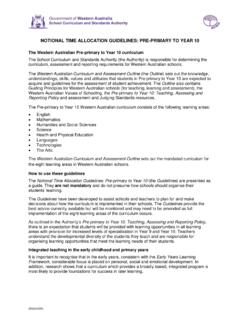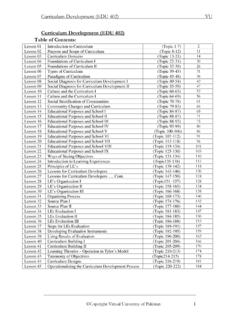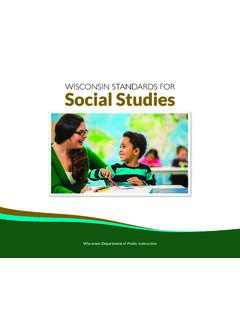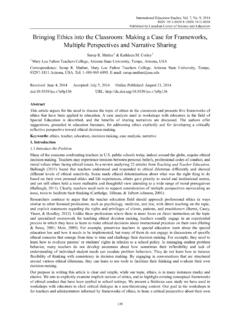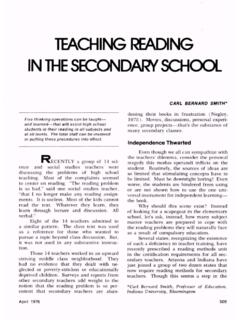Transcription of Curriculum Integration: An Overview - ed
1 CIMLE Current Issues in Middle Level education (2017) 22 (1), 36-40 Curriculum Integration: An Overview Amanda Wall and Alisa Leckie Georgia Southern University Curriculum integration is a tenet of middle level education . This We Believe, the position paper of the Association for Middle Level education , advocates for Curriculum that is exploratory, relevant, integrative, and meaningful for young adolescents. Teachers can integrate Curriculum across content areas by anchoring units of study in issues and themes that are determined along with students. Researchers have studied Curriculum integration in different capacities, and further research can continue to explore the impact of this approach to Curriculum .
2 Curriculum encompasses what happens in the school and includes academics as well as arts, physical education , extracurric-ular activities, and support services and programs (National Mid-dle School Association, 2010). There are many ways to implement Curriculum at the middle level. One approach to Curriculum em-phasized by middle school models is Curriculum integration ( , NMSA, 2010; Beane, 1993; Brown & Knowles, 2014). This over- view explores understandings of Curriculum integration and rele-vant research on this topic. Curriculum integration relates to This We Believe, the guiding document of the Association for Middle Level education (formerly the National Middle School Association), in its call for a middle school Curriculum that is challenging, exploratory, inte-grative, and relevant (NMSA, 2010).
3 This We Believe also encour-ages teachers and students to engage in active, purposeful learn-ing. Many descriptions and studies have shown that Curriculum integration can provide an engaging, purposeful, relevant, and meaningful approach to teaching and learning (Beane, 1993, 1997; Jacobs, 1989). What is Curriculum Integration? The meaning of Curriculum integration varies from source to source, and schools and teachers integrate Curriculum in different ways. James Beane, a prominent advocate for Curriculum integra-tion (1993, 1997, 2005), understands Curriculum integration to involve meaningful learning organized around issues important to teachers and students; in this way, Curriculum integration sup-ports democracy (Beane, 2005).
4 Beane outlined four aspects of integration that emphasize issues and align with democratic prin-ciples: integration of experiences, social integration, integration of knowledge, and integration as a Curriculum design. Integration of experiences means that past and present experiences are integrat-ed to facilitate new learning. Social integration occurs when stu-dents from diverse cultural perspectives enjoy common learning experiences. Integration of knowledge happens when content-area concepts are integrated through a focus on issues. Integra-tion as a design emphasizes project-based learning and other ap-plications of knowledge (Beane, 1993).
5 Beane (1997) anchored his concept of Curriculum integration in his principles for middle schools, namely that Curriculum should be general, and helpful for young adolescents exploring self and social meanings. Curriculum integration engages students as active learners who make the most of the decisions about what they study (Brown, 2016, p. 123). Designed to be responsive to stu-dents concerns, Curriculum integration allows for a model in which students become teachers and teachers become learn-ers (Pate, 2013, p. 174). Springer (2006), a leading practitioner, further noted that Curriculum integration takes as its ultimate aim helping students live better lives now as well as in the future, not merely gathering more information for possible later use (p.)
6 14). Similarly, Dowden (2007), writing about Curriculum integra-tion in Australian middle schools, stated that its main purpose is to resituate subject matter into relevant and meaningful con-texts ( ). Topics, themes, and issues that are meaningful for students can provide a starting point for Curriculum integration (Jacobs, 1989; Nesin & Lounsbury, 1999). Researchers, administrators, teachers, and teacher educators have interpreted Curriculum integration in various ways. They also have used different terminology to describe their approaches be-cause, as researchers and practitioners have noted, there is little consensus on what terms like Curriculum integration, interdisciplinary Curriculum , content integration, core Curriculum , and multidisciplinary curric-Current Issues in Middle Level education (2017) 22 (1), 36-40 36 ulum mean (Applebee, Adler, & Flihan, 2007; Czerniak, Weber, Sandmann, & Ahern, 1999; Springer, 2013).
7 Some resources have delineated Curriculum integration from other approaches by using metaphors like a pyramid (Manning & Bucher, 2012), or a contin-uum (Brown & Knowles, 2014; Jacobs, 1989; Kellough & Carju-zaa, 2009; Mathison & Freeman, 1997; cf. Greene, 2005) with subject-centered Curriculum on one end and student-centered Curriculum integration on the other. Along the continuum, con-nections among content areas may increase (Brown & Knowles, 2014; Jackson, 2005; Mathison & Freeman, 1997). Mathison and Freeman (1997) synthesized research on inter-disciplinary and integrated Curriculum and articulated three cate-gories: interdisciplinary, integrated, and integrative Curriculum .
8 They defined interdisciplinary Curriculum as more content-centered, while integrative Curriculum is more student-centered, aligning with Beane (1997). Springer (2013) also acknowledged the trouble with names and noted that interdisciplinary curricu-lum maintains the distinct disciplines (p. 192). Curriculum inte-gration, by contrast, focuses on broad themes without strict con-tent-area delineations. The conceptions of Curriculum above de-rive from theoretical works and middle school handbooks; it is also important to turn to research on Curriculum integration.
9 Examples of Curriculum Integration Examining the research on Curriculum integration presents a challenge since there is little uniform understanding of what cur-riculum integration is, which is compounded when terms like interdisciplinary or integrated are often used interchangeably, as noted by Nesin and Lounsbury (1999), Springer (2013), and others. Research on Curriculum integration often focuses on exam-ples of integration between two or three content areas; it is not necessary to integrate all content areas. Two content areas typical-ly integrated are language arts and social studies (Applebee, Adler, & Flihan, 2007; Authors, 2016), or science and math (MacMath, Roberts, Wallace, & Chi, 2010; Offer & Vasquez-Mireles, 2009).
10 As an example, researchers in one study (Stinson, Harkness, Mey-er, & Stallworth, 2009) wrote six teaching scenarios reflecting models of math-science integration described by Davidson, Mil-ler, and Matheny (1995): discipline, content, process, methodolog-ical, and thematic. Stinson and colleagues asked 33 middle school math and science teachers to read the scenarios and indicate whether each represented Curriculum integration and, if so, how; teachers also were asked to share their own examples of math-science integration. Results showed that teachers did not apply common understandings of math-science integration.










